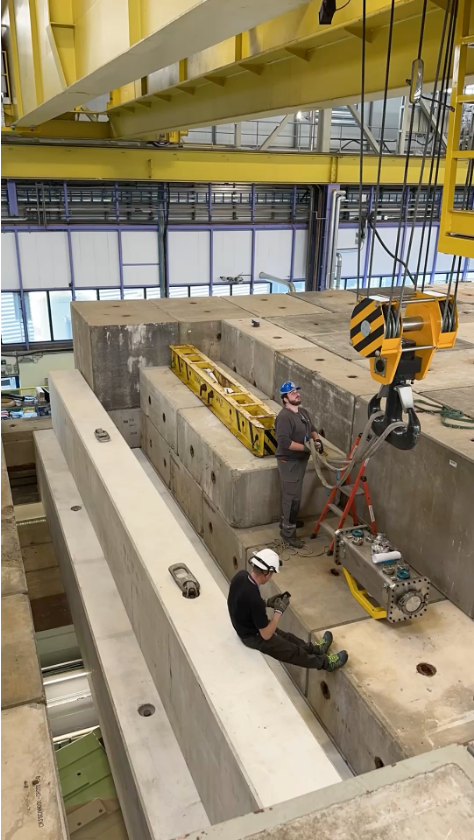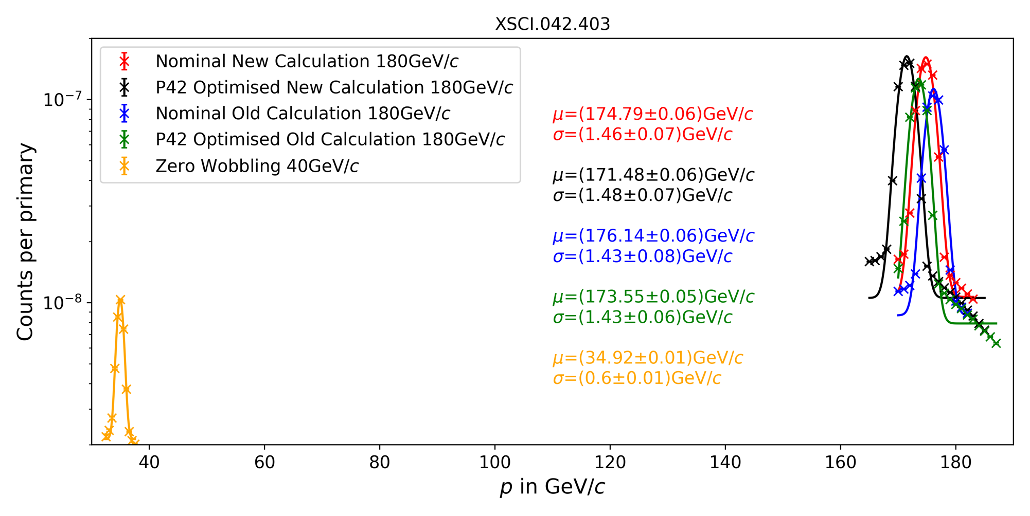Following an intense YETS, beam commissioning for the North and East experimental areas began smoothly and on schedule. Thanks to the coordinated efforts of the many teams involved, all beamlines were promptly handed over to users — setting the stage for what promises to be a full and exciting year of physics and test beams.
East Area: Back in Action After a Few Twists
The 2025 East Area beam commissioning wrapped up on schedule, despite a few unexpected challenges along the way. All YETS activities were completed on time, including key upgrades: the T10 beamline now offers a low-momentum option down to 0.1 GeV/c, enabled by improved vacuum throughout the line to reduce material interactions. A vacuum chamber was also installed inside one of the magnets for the upcoming low-energy ion run of CHIMERA/HEARTS, replacing a 4 m air section and thus improving beam quality for irradiations.
Commissioning wasn’t without surprises: On 7 March, a polarity check revealed movement of the newly installed vacuum chamber. Thanks to quick coordination between BE-EA and related teams, it was removed in time to keep the commissioning on track. A reinforced design is now in preparation for reinstallation later in the year during a technical stop.
Then, just ahead of the planned start of physics, a collimator failed on the evening of 18 March. The resulting intervention required removing the East Hall’s mixed-area roof shielding — a first since the LS2 renovation. Despite the complexity of the task, the collimator was successfully replaced in under 48 hours. This involved close collaboration between many teams, in particular transport, survey, radiation protection, BE-CEM, BE-OP, and BE-EA. Beam commissioning resumed on 21 March with minimal downtime, and physics began as scheduled.

North Area: Early Beams, Smooth Commissioning
Beam commissioning in the North Area began on the afternoon of 4 April, shortly after all permits were signed. SPS beams reached all three targets — T2, T4, and T6 — that same evening, and secondary beamlines were already seeing first particles. Commissioning continued steadily through the weekend and the following week.
Reference measurements — including electron purity, rates, and spot sizes — were carried out to inform the experiments and test beam users of the beam capabilities for the year, but also to have a reference for re-commissioning after the first phase of NA-CONS after LS3. Dedicated support from many groups, such as BE-OP, SY-BI, and BE-CEM, was instrumental throughout the process. Meanwhile, BE-EA actively tested newly developed tools to facilitate beam scans and ease the transition from CESAR to the new control software.
Thanks to this collaborative effort, most EHN1 beamlines were handed over to users ahead of schedule. Some test were already completed for the HI-ECN3 project during commissioning, in particular around the T4 target and for matching the new optics of the TT20 line to P42. Tuning of the M2, P42, and K12 lines also proceeded smoothly, on time for the EHN2 and ECN3 physics program beginning as planned on 17 April.

Outlook for 2025: Full Schedules and First Steps
This year is shaping up to be especially active, with a record number of test-beam user requests already on the books. In the East Area, the Water Cherenkov Test Experiment (WCTE) is concluding its beam campaign that lasted over several months. The experiment is contributing to detector R&D for future long-baseline neutrino programs. Later this year, CLOUD will resume operations, continuing its investigations into the influence of cosmic rays on atmospheric chemistry and cloud formation. The irradiation facilities IRRAD and CHARM are already running at full speed, while CHIMERA/HEARTS expects ion beams towards the end of the year.
In the North Area, NA62 continues its data taking after last year’s 5-sigma observation of the rare decay K⁺ → π⁺νν̅, a major milestone in rare kaon physics and a stringent test of the Standard Model. AMBER will aim to measure the proton radius with high precision using muon scattering, while MUonE is preparing its first pilot data-taking campaign to probe hadronic contributions that might help to understand the muon g-2 anomaly.
With a strong start already behind us, and many exciting experiments ahead, we’re well set for a dynamic and rewarding year in the experimental areas. Thanks again to all teams involved for the continued collaboration and energy that make it all possible.
— D. Banerjee, N. Charitonidis and J. Bernhard for the EA operation team
